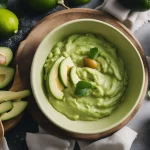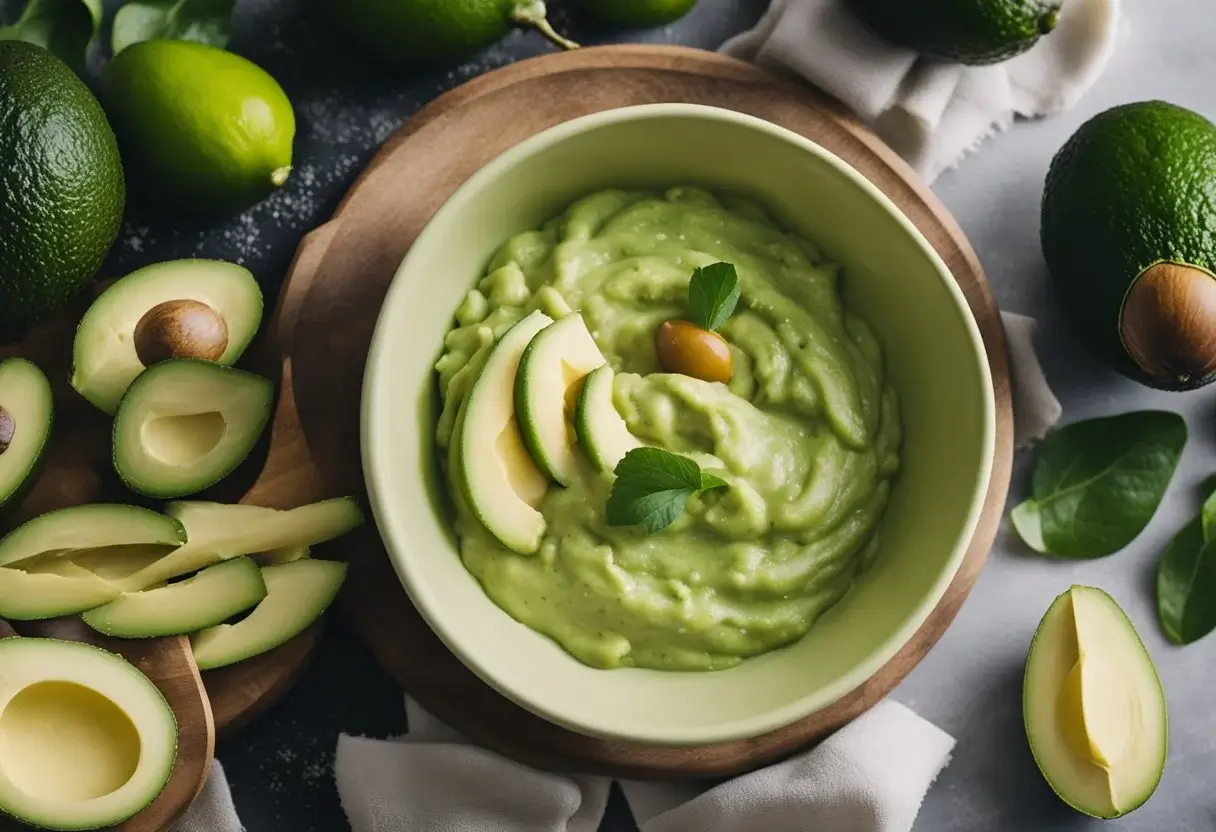Avocado sauce has become a popular condiment in recent years, thanks to its creamy texture and versatile flavor. As someone who loves experimenting with different sauces and dips, I was excited to try avocado sauce for the first time. I was pleasantly surprised by how easy it was to make and how delicious it tasted.
Avocado sauce is typically made with ripe avocados, garlic, lime juice, and salt. Some recipes also include cilantro, jalapeno, or other spices to add extra flavor. The sauce can be used as a dip for chips or veggies, a topping for tacos or burritos, or even as a salad dressing. With its healthy fats and nutrients, avocado sauce is a great alternative to traditional mayonnaise or sour cream-based sauces.
History of Avocado Sauce
Origins
Avocado sauce, also known as guacamole, has been a staple in Mexican cuisine for centuries. The Aztecs were known to have mashed avocados with tomatoes and onions to create a sauce that was served with their meals. The word “guacamole” is derived from the Aztec word “ahuacamolli,” which means “avocado sauce.”
In the early 1900s, avocado sauce began to gain popularity in the United States, particularly in California. It was often served as a dip with tortilla chips and became a favorite at parties and gatherings.
Cultural Significance
Avocado sauce has become a cultural icon in Mexican cuisine and is now enjoyed worldwide. It is a versatile sauce that can be used as a dip, spread, or topping for various dishes. In addition to its delicious taste, avocado sauce is also known for its health benefits. Avocados are high in healthy fats, fiber, and vitamins, making it a nutritious addition to any meal.
Today, avocado sauce is not only a popular condiment in Mexican cuisine but also in many other cuisines around the world. It has become a symbol of healthy eating and is often used as a substitute for mayonnaise or other high-fat condiments.
Overall, the history of avocado sauce is a rich and flavorful one. From its humble beginnings in Aztec cuisine to its current status as a beloved condiment, avocado sauce has come a long way and continues to be enjoyed by people of all cultures and backgrounds.
Preparation Techniques
Selecting Ingredients
When making avocado sauce, it is important to select the right ingredients to ensure the best possible flavor and texture. The main ingredient, of course, is ripe avocados. Look for avocados that are slightly soft to the touch but not mushy. They should also be dark green or black in color. Other ingredients to consider include lime juice, garlic, cilantro, salt, and pepper.
When selecting lime juice, it is best to use freshly squeezed juice rather than bottled juice. This will give the sauce a fresher and more vibrant flavor. Garlic should be fresh and finely minced to prevent any large chunks in the sauce. Cilantro should be washed and dried thoroughly before being chopped finely. Salt and pepper should be added to taste, but be careful not to overdo it as the avocados already have a natural creaminess and flavor.
Blending Methods
There are various methods to blend avocado sauce, but the most popular one is using a food processor or blender. To begin, cut the avocados in half and remove the pit. Scoop out the flesh and place it in the food processor or blender. Add the remaining ingredients and blend until smooth.
Another method is to use a mortar and pestle. This method requires more effort but can yield a chunkier and more rustic sauce. Begin by mashing the garlic and salt together in the mortar. Add the chopped cilantro and continue to mash until it forms a paste. Add the avocado flesh and lime juice and continue to mash until the desired texture is achieved.
No matter which method you choose, be sure to taste the sauce and adjust the seasoning as needed. Serve immediately or store in an airtight container in the refrigerator for up to 2 days.
Nutritional Information
Health Benefits
As a nutritionist, I can confidently say that avocado sauce is a healthy addition to any meal. Avocados are packed with nutrients, including vitamins C, K, and B6, as well as potassium, fiber, and healthy fats. These nutrients are essential for maintaining a healthy body and reducing the risk of chronic diseases.
One of the most significant health benefits of avocado sauce is its ability to lower cholesterol levels. The monounsaturated fats found in avocados can help reduce bad cholesterol levels while increasing good cholesterol levels. This can lead to a reduced risk of heart disease and stroke.
Avocado sauce also contains antioxidants, which can help reduce inflammation in the body. Chronic inflammation has been linked to many diseases, including cancer, diabetes, and Alzheimer’s disease. By including avocado sauce in your diet, you can help reduce your risk of these diseases.
Caloric Content
While avocado sauce is a healthy addition to any meal, it is important to keep in mind its caloric content. One tablespoon of avocado sauce contains approximately 25 calories and 2 grams of fat. While this may not seem like a lot, it can add up quickly if you are not careful.
To keep your caloric intake in check, it is important to use avocado sauce in moderation. Consider using it as a condiment or dressing instead of a main ingredient. You can also try making your own avocado sauce at home using fresh ingredients to control the calorie and fat content.
Overall, avocado sauce is a delicious and healthy addition to any meal. By understanding its nutritional information, you can make informed decisions about how to include it in your diet.
Culinary Uses
Traditional Pairings
Avocado sauce is a versatile condiment that pairs well with many traditional dishes. One of the most popular uses of avocado sauce is as a topping for tacos, burritos, and other Mexican dishes. Its creamy texture and tangy flavor complement the spiciness of these dishes, making it a perfect addition to any fiesta.
In addition to Mexican cuisine, avocado sauce is also commonly used as a dip for vegetables, chips, and crackers. Its smooth texture and mild flavor make it a healthier alternative to other dips like sour cream or ranch dressing.
Another traditional pairing for avocado sauce is with grilled meats, such as chicken or steak. The richness of the sauce balances the smoky flavor of the meat, creating a delicious combination that is sure to please any carnivore.
Modern Adaptations
While avocado sauce has been a staple in traditional dishes for decades, it has also found its way into modern cuisine. One popular use of avocado sauce is as a spread on sandwiches and burgers. Its creamy texture and mild flavor make it a healthier alternative to mayonnaise or other high-fat spreads.
Another modern adaptation of avocado sauce is as a dressing for salads. Its tangy flavor and smooth texture make it a perfect complement to leafy greens and other vegetables.
Finally, avocado sauce can also be used as a marinade for seafood, such as shrimp or salmon. Its rich flavor and creamy texture infuse the fish with a delicious taste that is sure to impress any seafood lover.
Overall, avocado sauce is a versatile condiment that can be used in many different ways. Its mild flavor and creamy texture make it a healthy and delicious addition to any dish.
Frequently Asked Questions
How do you make a creamy avocado sauce for pasta?
To make a creamy avocado sauce for pasta, start by blending ripe avocados, garlic, lime juice, salt, and pepper in a food processor or blender until smooth. Then, slowly add in olive oil and a bit of water until the sauce reaches your desired consistency. For an extra creamy texture, you can also add in some Greek yogurt or sour cream.
What are the essential ingredients for a basic avocado sauce?
The essential ingredients for a basic avocado sauce are ripe avocados, garlic, lime juice, salt, and pepper. You can also add in other ingredients like cilantro, jalapeno peppers, or red onion for additional flavor.
Can avocado sauce be used as a topping for chicken dishes?
Yes, avocado sauce can be used as a topping for chicken dishes. It pairs well with grilled or roasted chicken, and can also be used as a dip for chicken tenders or nuggets.
What distinguishes avocado sauce from guacamole in terms of preparation and use?
Avocado sauce is typically smoother and creamier than guacamole, and is made by blending the ingredients together in a food processor or blender. Guacamole, on the other hand, is typically made by mashing the ingredients together with a fork or potato masher. Avocado sauce is often used as a condiment or topping, while guacamole is typically served as a dip.
Is there a preferred type of avocado for creating a smooth sauce for fish?
Hass avocados are typically the best choice for creating a smooth avocado sauce for fish. They have a creamy texture and rich flavor that pairs well with seafood.
What are some creative variations of avocado sauce for fajitas and tacos?
Some creative variations of avocado sauce for fajitas and tacos include adding in ingredients like roasted red peppers, chipotle peppers in adobo sauce, or mango. You can also experiment with different herbs and spices, like cumin or smoked paprika, to add extra flavor.

Avocado Sauce
- Author: recipstep
- Total Time: 5 minutes
- Yield: About 1 cup 1x
- Diet: Vegan
Description
This Avocado Sauce is a smooth, creamy condiment that’s perfect for drizzling over tacos, salads, or using as a dip for chips and vegetables. Made with ripe avocados, fresh cilantro, lime juice, and garlic, it’s a burst of freshness in every bite.
Ingredients
1 large, ripe avocado
1/3 cup sour cream or yogurt
1/2 small clove of garlic
Juice of 1/2 lemon
1–2 tbsp olive oil
1/2 cup (packed) coriander/cilantro, roughly chopped
Salt and pepper to taste
Instructions
Prepare Ingredients: Gather all the ingredients to ensure a smooth process.
Blend the Goodness:
In a food processor, combine the ripe avocado, sour cream or yogurt, garlic, lemon juice, olive oil, and chopped coriander/cilantro.
Blend until the mixture is very smooth. Use water to adjust the consistency if needed.
Taste & Adjust:
Season the avocado sauce with salt and pepper to taste.
Adjust the amount of lemon juice according to your preference. It should have a bit of tang if intended to be paired with rich, bold-flavored foods like Mexican cuisine.
Storage Tips:
Transfer the avocado sauce to an airtight container.
Keeps well for up to 4 days and maintains its vibrant green color.
Enjoy
Notes
- For a spicier sauce, add a jalapeño or a dash of your favorite hot sauce.
- This sauce is best used fresh but can be stored in the refrigerator for up to 24 hours. Place plastic wrap directly on the surface to prevent browning.
- Prep Time: 5 minutes
- Cook Time: 0 minutes
- Category: Sauce/Dip
- Method: Blending
- Cuisine: Mexican-Inspired
Nutrition
- Calories: 160 kcal
- Sugar: 1 g
- Sodium: 10 mg
- Fat: 15 g
- Saturated Fat: 2 g
- Carbohydrates: 9 g
- Fiber: 7 g
- Protein: 2 g






